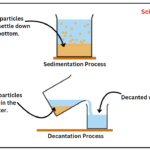What are Canal Rays: Discovery, Properties
In this chapter, we will understand what canal rays are, along with their discovery and properties.
Canal rays, also known as anode rays, are streams of positively charged particles or ions that are created in a discharge tube when a high voltage is applied across a gas at low pressure. These rays are also known as anode rays because they are originated from the anode.
Canals rays travel in the direction opposite to that of cathode rays, i.e. from anode to the cathode. These rays were termed canal rays since these passed through the canals of the cathode. Hence the name “canal rays,” which comes from the German word “Kanalstrahlen“.
When Thomson studied the properties of these rays, he observed that these rays consisted of positively charged particles and named them as positive rays. Unlike cathode rays, which are composed of electrons and have a negative charge, canal rays are composed of positive ions, making them positively charged.
Discovery of Canal Rays (Anode or Positive Rays)
With the discovery of negatively charged particles called electrons, scientists started looking for positively charged particles, which were naturally expected because an atom is electrically neutral under normal conditions.
In 1886, a scientist, Eugene Goldstein, conducted the first experiment that led to the discovery of a new type of rays called positive rays. He used a perforated cathode in the modified cathode ray tube, as shown in the below figure.

He observed that when a high electrical voltage is applied to the electrodes of discharge tube containing hydrogen gas at a very low pressure, not only cathode rays are produced but also a new type of rays are produced simultaneously from anode moving towards cathode and passes through the holes or canals of the cathode.
In simple words, not only cathode rays are traveling from cathode to anode but also some new rays are traveling from anode to cathode and pass through holes of cathode (i.e. perforated cathode). These rays are named canal rays or anode rays because they passed through holes or canals in the cathode. These rays caused a fluorescent glow on striking the wall coated with ZnS opposite to the anode.
Thomson studied these anode rays and revealed that they consisted of particles carrying a positive charge. He called them positive rays.
Properties of Canal Rays (Positive Rays)
Further study of these rays shows that they are composed of positively charged material particles. Some of the characteristic properties of the canal rays or positive rays are as follows:
- Canal or anode rays are the stream of positively charged particles that travel in straight lines in a direction opposite to the cathode.
- The rays are composed of material particles that have mass and occupy space.
- Similar to electron, the electric field and magnetic field also deflects canal rays in the direction opposite to that of cathode rays. These rays are attracted towards the negatively charged plate indicating that they carry positive charge.
- The charge-to-mass ratio (e/m) of positive particles in the anode rays is not constant. It varies with the nature of the gas taken in the discharge tube.
- The mass of canal rays is significantly higher than that of electrons because they are composed of cations (positive ions), which are much heavier than electrons.
- The speed of anode rays is much lower than that of cathode rays due to their greater mass.
- The rays striking the glass walls of the discharge tube produce flashes of light on the zinc sulphide screen.
- Like cathode rays, these rays also rotate the wheel placed in their path and also have a heating effect. Thus, the rays possess kinetic energy, i.e., mass particles are present.
- Anode rays can pass through thin metal foils.
- These rays can produce ionisation in gases.
- These rays are capable of producing physical and chemical changes.
How are Positive Rays Produced ?
Positive rays are produced in a gas discharge tube, which is a sealed glass tube containing a gas at low pressure. Here’s how the process works:
(1) Cathode Rays (High-Speed Electrons): When a high voltage is applied, the cathode (negative electrode) emits electrons. These high-speed electrons are called cathode rays.
(2) Ionization of Gas Molecules: As these high-speed electrons travel towards the anode (positive electrode), they collide with the gas molecules in the tube. These collisions are energetic enough to knock out one or more electrons from the gas molecules. This process is known as ionization.
M + e− → M+ + 2e−
Here, M represents a neutral gas molecule, e− represents an electron, and M+ represents the positively charged ion formed when an electron is knocked out.
(3) Formation of Positive Ions: The ionization of gas molecules results in the formation of positive ions (cations). These ions are positively charged because they have lost one or more electrons.
(4) Movement of Positive Ions Toward the Cathode: These positively charged ions are then attracted towards the cathode due to the electric field established between the cathode and anode.
(5) Passing Through Perforated Cathode: If the cathode is perforated (has small holes in it), the positive ions pass through these holes and continue moving towards the opposite end of the discharge tube. This stream of positive ions constitutes the positive rays or canal rays.
(6) Composition of Positive Rays: The positive rays are composed of ions whose properties depend on the type of gas in the tube. For example, if the gas is hydrogen, the positive ions are protons (H+). If the gas is neon, the ions are Ne+.
Thus, positive rays are streams of positive ions formed by the ionization of gas molecules in a discharge tube. These rays are produced when high-speed electrons from the cathode strike gas molecules, causing them to lose electrons and form positively charged ions. The ions then travel through the perforated cathode and create the visible canal rays.
Frequently Asked Questions based on Canal Rays
1. What are canal rays?
Canal rays are streams of positively charged ions that originate in a gas discharge tube when a high voltage is applied across a gas at low pressure. These rays travel in the opposite direction to cathode rays which are streams of electrons.
2. Who discovered canal rays or anode rays?
Eugen Goldstein discovered canal rays in 1886.
3. How are canal rays different from cathode rays?
Canal rays differ from cathode rays in several ways:
(1) Charge: Canal rays are positively charged, while cathode rays are negatively charged.
(2) Composition: Canal rays consist of cations (positive ions), whereas cathode rays consist of electrons (negative).
(3) Mass: The particles in canal rays are much heavier than those in cathode rays due to the mass of ions compared to electrons.
(4) Direction: Canal rays travel towards the cathode, while cathode rays move towards the anode.
4. How are canal rays produced?
Canal rays are produced in a gas discharge tube when a high potential difference is applied between the electrodes at low pressure. The electric field causes electrons to accelerate towards the anode, ionizing the gas molecules. The positive ions so formed are then accelerated towards the cathode, formed canal rays.
5. Why are canal rays called “positive rays”?
Canal rays are called “positive rays” because they consist of positively charged ions.
6. Can anode rays be deflected by electric and magnetic fields?
Yes, canal rays can be deflected by electric and magnetic fields. However, they are deflected in a direction opposite to cathode rays because they carry a positive charge. The degree of deflection depends on the mass and charge of the ions.
7. What is the role of gas in the production of anode rays?
The type of gas in the discharge tube determines the composition of the canal rays. Different gases produce different positive ions when ionized, which affects the mass and charge of the canal rays.






